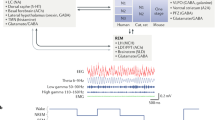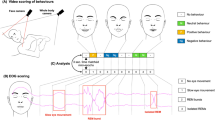Abstract
THE cyclic nature of sleep in mammals, including the regular recurrence of a state characterized by a low voltage desynchronized electroencephalogram, rapid eye movements, and heightened autonomic activity, is now firmly established1,2. This state, associated in humans with dreaming, has been called “dreaming state”, “rapid eye-movement sleep” or “paradoxical sleep”, and we refer to it as the “D-state”3.
This is a preview of subscription content, access via your institution
Access options
Subscribe to this journal
Receive 51 print issues and online access
$199.00 per year
only $3.90 per issue
Buy this article
- Purchase on Springer Link
- Instant access to full article PDF
Prices may be subject to local taxes which are calculated during checkout
Similar content being viewed by others
References
Aserinsky, E., and Kleitman, N., Science, 118, 273 (1953).
Dement, W. C., and Kleitman, N., Electroenceph. Clin. Neurophysiol., 9, 673 (1957).
Hartmann, E., New Engl. J. Med., 273, 30 (1965).
Dement, W. C., Science, 131, 1705 (1960).
Jouvet, M., Arch. Ital., 100, 125 (1962).
Hartmann, E., Verdone, P., and Snyder, F., Report to the Association for the Psycho-physiological Study of Sleep (March, 1964).
Author information
Authors and Affiliations
Rights and permissions
About this article
Cite this article
HARTMANN, E. Mechanism underlying the Sleep–Dream Cycle. Nature 212, 648–650 (1966). https://doi.org/10.1038/212648b0
Published:
Issue Date:
DOI: https://doi.org/10.1038/212648b0
This article is cited by
-
Ultradian cycles in mice: definitions and links with REMS and NREMS
Journal of Comparative Physiology A (2007)
-
Pavlovian theory of dreaming
The Pavlovian Journal of Biological Science (1974)
Comments
By submitting a comment you agree to abide by our Terms and Community Guidelines. If you find something abusive or that does not comply with our terms or guidelines please flag it as inappropriate.



